Last week, the Chinese Communist Party (CCP) organized the World Robot Conference, where they showcased the latest advancements that China’s robotics industry has produced over the past several years. According to the CCP, China’s humanoid robots are “catching up fast with global rivals,” with advances such as the incorporation of AI into some of its robots that have military capabilities.
We’re picturing mindless robot patrols enforcing the next ‘welded in’ pandemic lockdown, with deadlier results. As Anders Corr notes in The Epoch Times, China’s humanoid robots on display at the conference could easily be equipped with weapons and probably already have been. The People’s Liberation Army has demonstrated armed flying drones and quadruped AI robots that resemble dogs with machine guns mounted to their backs. The killer robot dogs can reportedly fire their weapons autonomously.
China’s rapid rise in robotics is state-directed and subsidized to the tune of over $1.4 billion, according to an official announcement in 2023. In 2012, China installed fewer than 15 percent of industrial robots globally. By 2022, that number increased to over 50 percent, with China installing over 250,000, the most in the world. By comparison, Japan and the United States installed just about 50,000 and 40,000, respectively.
In 2016, a Chinese company bought Germany’s Kuka, one of the world’s three leading industrial robot makers. The other two are Japan’s Fanuc and Switzerland’s ABB. Tesla is also a leading robot maker. It plans to deploy 1,000 humanoid Optimus robots in Tesla factories in 2025. Given the close connections of all four of these companies to China, there is a significant risk of technology transfers and IP theft, further driving China’s rapid rise in the robotics space.
On March 25, a Chinese company called LimX Dynamics revealed an advanced biped robot that navigates rocky, grassy, hilly, and other challenging terrain. This technology could be used to develop military robots capable of performing tasks in harsh environments. The potential for misuse of such technology is concerning, as it could lead to the development of autonomous weapons systems that are difficult to control or regulate.
The CCP may be hiding its robotics capabilities as much as it hides its superior supercomputer capabilities. The CCP can use Boston Dynamics as inspiration. It has already consciously used companies with more advanced technologies, like Tesla, as a “catfish” to spur more rapid development in China.
If AI were to ever escape human control in a breakout, which many AI experts worry about, it could potentially hack many of the world’s robots and much of the world’s Internet of Things (IoT), thus expanding AI’s ability to surveil the environment and act in it physically and autonomously.
Even if the risk of an AI breakout or mass CCP hack of U.S. robots and IoT has a low probability of ever becoming a reality, its high cost is such that regulations and legislation are being proposed in the United States and elsewhere. These are meant to address what is known as a “black swan” event that is of low probability but high cost and, therefore, a risk to be mitigated.
Rep. Vern Buchanan (R-Fla.), for example, recently proposed an amendment requiring an annual Pentagon report on threats to the United States from China’s AI military technology, including armed AI robot dogs. The amendment passed the House without a single opposition vote from either party.
Deterring China’s use of the dangerous combination of AI and military robotics—and the arms race it starts—requires more than just military innovation on our part. It requires removing the CCP from its control of the world’s most powerful manufacturing base in China so that all countries can back away from the brink of developing ever more powerful and unregulated AI-enabled military robotics. Given that the CCP is averse to arms control and can’t be trusted even if it is welcomed as much, that can be done through no less than an ethical sea-change in China that most likely will require its democratization.
Views expressed in this article are opinions of the author and do not necessarily reflect the views of The Epoch Times or ZeroHedge.




